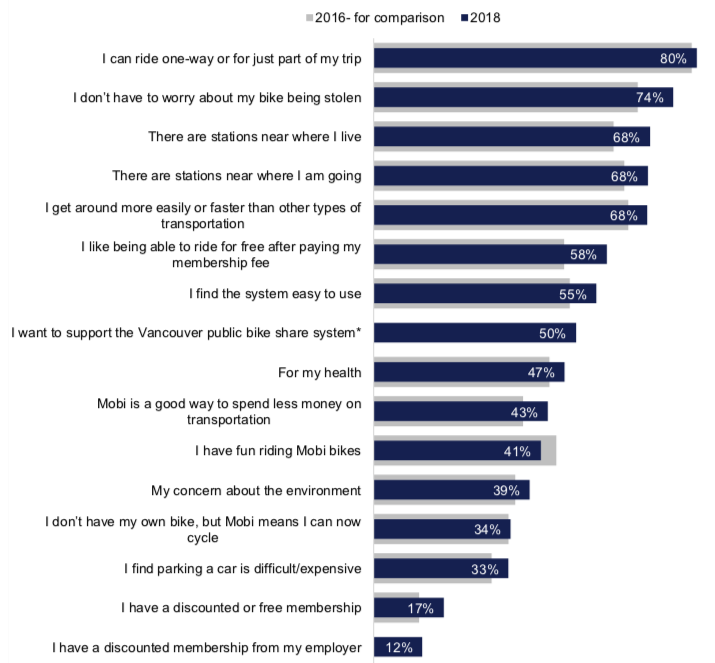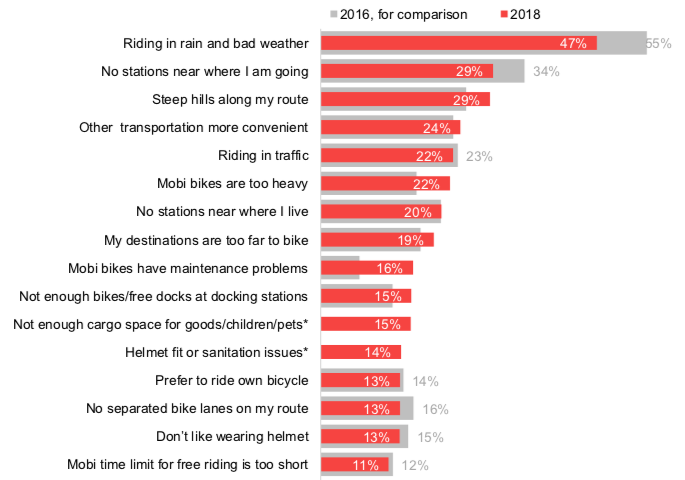Overview
Bike share programs increase access to and use of bicycles by deploying docking stations throughout a city, enabling individuals to make one way bike trips for minimal fees. Such interventions can increase cycling but also walking and transit use, as they help provide efficient connections to and from transit networks, and increase time competitiveness of sustainable modes compared with personal motor vehicles. The systems use adjustable “city-style” bikes, which are easy to ride for people of all abilities.
Public bike share programs remove certain barriers related to bicycle ownership, including concern for theft or vandalism, lack of parking or storage, and maintenance requirements. The programs are becoming common in urban centres, and increasingly massive in scope. Canada is joining this global trend: the first public bike share began in Montreal in 2009 (with 7250 bikes in 2019), and programs were launched in 2014 in Toronto (3750 bikes in 2019) and in 2016 in Vancouver (1750 bikes in 2019).
Vancouver bike share
A unique aspect of the Vancouver bike share program is that the province has an all-ages helmet law that applies to cycling on roads and the city has a bylaw requiring helmets on most off-road paths. The bike share system includes a helmet with every bike. Other large Canadian bike share systems are in provinces that do not legislate helmet use at all (Quebec) or for adults (Ontario) and helmets are not provided. Helmet legislation has been debated as a barrier to uptake of cycling and is seen as a potential threat to the success of bike share programs.
Our study
We are taking advantage of the launch of the Vancouver bike share program to examine its impact on travel and health outcomes in the general population, in users of the program, and within key populations. We have the following objectives:
- to estimate the impact of public bike share on changes in physical activity and mode of transportation at a population-level
- to determine who uses the bike share program and its impact on their individual health and modes of transportation
- to characterize barriers to the adoption of the bike share program across socio-demographic groups.
Population-level use, motivators, & barriers
Telephone surveys of ~1000 Vancouver residents prior to and after the summer 2016 launch of Vancouver’s public bike share program showed that a majority (~70%) thought it was a good idea for the City. 43% had travelled by bicycle in the past 12 months, and of the 57% of the Vancouver population who had not used a bicycle in the previous year, 37% said they would consider using a bicycle in the future.
Before the program was implemented, 24% said they were likely to use it, but only 6% had one year after its inauguration. The bike share system did not have an impact on bicycling throughout the city, but was associated with a doubling of bicycling among those who both lived and worked in the service area of the bike share system.
Of those who had not yet used bike share one year into program operation, 23% said they were likely to use it within the next year (potential users) and 77% said they were unlikely to use it. Compared to unlikely users, potential users tended to be younger, employed, have lower incomes, use public transit as their primary mode of transportation, and not own a personal bicycle.
The pre-implementation survey indicated that the most important factors influencing Vancouverites’ likelihood of using the program were a connected network of protected cycle routes and good weather. Post-implementation, top motivators included health/exercise (45%); stations near their home (45%) and destination (37%); and not owning a personal bicycle (40%). The top barriers to using using the system were related to satisfaction with current transportation modes, followed by environmental factors. Cost was a deterrent to 20% of unlikely users, notable given that they have lower incomes than Mobi members (see below).
Bike share member motivators & barriers
By 2018, about 5000 people had bike share memberships in Vancouver. Compared to the Vancouver population, members were more likely to be male, younger to middle aged, born in Canada, employed, highly educated, and from a higher income household.
A 2018 survey of members indicated that 39% of trips replaced a walking trip, 35% a transit trip, 17% a car trip, and 7% a personal bike trip. Most trips were combined with another mode of travel.
Top motivators 
Top barriers

Helmets & bike share
Before the program was implemented, news media reported that the BC helmet law was the likely leading barrier to bike share success in Vancouver. In the population survey, helmets were reported as frequently used (on 75-80% of cycling trips), but about 57% of cyclists reported not using helmets on at least some trips. Lack of access to a helmet and discomfort were the primary reasons for non-use.
Observations were made on fair weather days in 2016 at five screen-line sites and at 15 public bike share docking stations. Observers recorded helmet use, gender, bike facility type, and time of travel of 10,704 people riding personal bikes and 397 riding bike share bikes. Overall, the prevalence of helmet use was 78.1% (n=8,670/11,101), significantly higher for personal bike riders (78.6%) than bike share users (64.0%). Helmet use was more common among women, at weekday morning commute times, and on on-street bike facilities.
Publications
- Who are the ‘super-users’ of public bike share? An analysis of public bike share members in Vancouver, BC. Winters M, Hosford K, Javaheri S. Preventive Medicine Reports 2019;15:100946 [article]
- Who are public bicycle share programs serving? An evaluation of the equity of spatial access to bicycle share service areas in Canadian cities. Hosford K, Winters M. Transportation research record 2018 [article]
- Evaluation of the impact of a public bicycle share program on population bicycling in Vancouver, BC. Hosford K, Fuller D, Lear SA, Teschke K, Gauvin L, Brauer M, Therrien S, Winters M. Preventive Medicine Reports 2018 [article]
- Who is in the near market for bicycle sharing? Identifying current, potential, and unlikely users of a public bicycle share program in Vancouver, Canada. Hosford K, Lear SA, Fuller D, Teschke K, Therrien S, Winters M. BMC Public Health 2018 [article]
- Identifying the leaders: Applying diffusion of innovation theory to use of a public bike share system in Vancouver, BC. Therrien S, Brauer M, Fuller D, Gauvin L, Teschke K, Winters M.Transportation Research Board 2014 [article]
- Facilitators and barriers to public bike share adoption and success in a city with compulsory helmet legislation: A mixed-methods approach. Zanotto M. [SFU Thesis]
- Helmet use among personal bicycle riders and bike share users in Vancouver, BC. Zanotto M, Winters M. American Journal of Preventive Medicine 2017 [abstract]
- Assessing the modal impacts of public bikeshare systems: A comparison of survey tools. Hosford K, Fuller D, Gauvin L, Brauer M, Teschke K, Winters M. International Society of Behavioural Nutrition and Physical Activity 2017 Annual Meeting, Victoria. June 2017 [poster]
Reports
- 2020 Vancouver Bike Share Study summary of results: motivators, deterrents, equity [poster]
- 2018 Vancouver Bike Share 2018 Member Survey Results [report]
- 2017 Vancouver Population Survey Results Compared with Mobi Member Results, Understanding a New Bikeshare Program in Vancouver [report]
- 2017 Intercept Survey Findings, Understanding a New Bikeshare Program in Vancouver [report]
- 2017 Focus Group Findings, Understanding a New Bikeshare Program in Vancouver [report]
- 2016 & 2017 Mobi Member Survey Station Location Recommendations, Understanding a New Bikeshare Program in Vancouver [report]
- 2016 Mobi Member Survey Results, Understanding a New Bikeshare Program in Vancouver [report]



